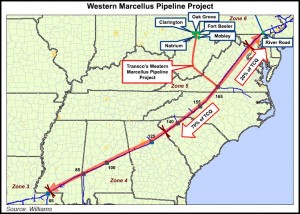Atlantic Sunrise Pipeline Price Tag Is $2.1 Billion
Williams Energy pipeline will service 7 million homes from NYC to Georgia
From an Article by Casey Junkins, Wheeling Intelligencer, April 14, 2015
Wheeling, WV – Williams Energy plans to service 7 million homes from New York City to Georgia with about 1.7 billion cubic feet of Marcellus Shale natural gas daily via its $2.1 billion Atlantic Sunrise pipeline project.
If the Federal Energy Regulatory Commission (FERC) grants approval, the Atlantic Sunrise will join several other pipeline projects designed to ship the natural gas drawn from West Virginia, Pennsylvania and Ohio to metropolitan markets.
“Atlantic Sunrise is a vital piece of North American energy infrastructure needed to transport low-cost, abundant supplies of natural gas from the Marcellus producing region in Pennsylvania to hungry markets along the Atlantic Seaboard,” Rory Miller, senior vice president of Williams Energy Atlantic-Gulf operating area, said. “Shippers have signed long-term commitments for the expansion’s entire capacity, which represents enough natural gas to serve approximately 7 million homes.”
The natural gas companies working in the Marcellus formation are now producing about 14.6 billion cubic feet daily, compared to just 1.3 Bcf per day in 2010. These yields could continue increasing once new pipeline projects are placed into service, the agency believes.
Williams officials hope to place the Atlantic Sunrise into service before the end of 2017 to keep up with demand for infrastructure. The new project will be an expansion and extension of Williams’ Transco pipeline system, which runs some 10,200 miles from south Texas to New York City, providing natural gas to numerous metropolitan areas along the way.
A Penn State University report indicates the Atlantic Sunrise pipeline’s design and construction would support about 8,000 temporary jobs, as well as 29 full-time jobs once the operation is running.
“Penn State’s report clearly shows how vital this project and others like it are for Pennsylvania’s economy,” Pennsylvania Chamber of Business & Industry President Gene Barr said. “We need to take advantage of all of our natural resources, and the best way to do that is through more gas infrastructure. The Atlantic Sunrise expansion to the Transco pipeline is projected to support thousands of jobs during construction and thousands more in the drilling and supply chain industries.”
The Atlantic Sunrise joins the following transportation systems developing to move Marcellus and Utica shale natural gas to large markets: the $5 billion Atlantic Coast Pipeline designed to ship gas to North Carolina; the Leach XPress that will send gas toward Huntington, W.Va.; the Mountain Valley Pipeline, which will ship gas southward from Wetzel County; and the Texas Eastern Transmission’s Gulf Markets Expansion project, operated by Spectra Energy, which will carry gas from the Upper Ohio Valley to Gulf Coast states.
>>>>>>>>>>>>
WV-DEP: 132 Barrels of NGL Spilled Into Marshall County Creek — Williams to be sanctioned for pollution by NGL condensate
From an Article by Casey Junkins, Wheeling Intelligencer, April 14, 2014
Glen Dale, WV – West Virginia regulators will cite Williams Energy for “conditions not allowable in state waters” after the company’s pipeline rupture allowed 132 barrels of Marcellus Shale condensate to spill into Little Grave Creek last week.
The 4-inch condensate conduit broke late Thursday, less than three hours before a 12-inch natural gas pipeline – also operated by Williams – failed in the Bane Lane area of Marshall County along U.S. 250.
“Other violations may be issued depending on the evolution and discovery of site conditions,” West Virginia Department of Environmental Protection spokeswoman Kelley J. Gillenwater said of the 4-inch pipeline rupture. “The condensate has impacted approximately 6 miles of Little Grave Creek in Marshall County.”
Gillenwater said a visible sheen remains along Little Grave Creek, along with a slight odor. This stream ultimately leads to the Ohio River, but she said no drinking water intakes have been impacted. Gillenwater said an environmental remediation company hired by Williams has placed containment booms in the creek to prevent the material from proliferating.
“Williams has and will continue to take water samples of Little Grave Creek starting at the mouth of the Ohio River, and sampling all public accesses of the stream to the right of way,” Gillenwater said. “An unnamed tributary is also believed to have been impacted and this stream is also being sampled.”
Friday, Williams spokeswoman Helen Humphreys said company officials believe “heavy rains in the area, which may have destabilized soils, were a contributing factor” in the two pipeline failures late Thursday. Monday, Humphreys said both pipelines remain shutdown as company and state inspectors determine the full cause of the ruptures before initiating repairs.
Williams transports natural gas and liquids for Chevron, Southwestern Energy, Gastar Exploration, Trans Energy, and several other producers in northern West Virginia. The firm operates a massive pipeline and processing infrastructure network in Marshall County. It runs the Oak Grove processing plant, the Fort Beeler processing plant and the Moundsville fractionator, all of which are connected by pipelines.
Humphreys said the 12-inch line that broke near Bane Lane Thursday collects natural gas from producing wells throughout the area for shipment to the nearby Fort Beeler plant. She said officials knew they had a problem because of a noticeable pressure drop.
“Company personnel have taken soil samples in the area of the rupture and are developing a recovery plan,” she said of remediation efforts related to this failure.
On April 5, 2014, a 12-inch Williams pipeline ruptured near the Oak Grove plant. After the investigation, Gillenwater said this “explosion created a 10-foot crater, and the resulting fire scorched trees over an approximately 2-acre area.”Unlike last year’s event, Humphreys said neither Thursday rupture created a fire.
See also: www.MAREproject.org

